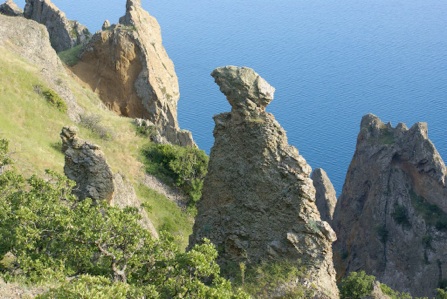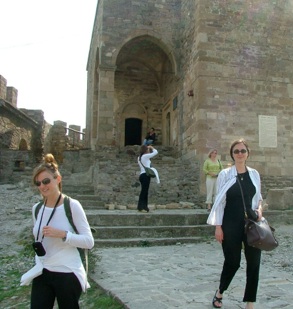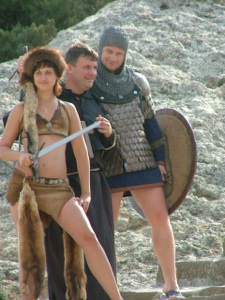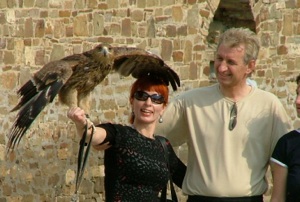2007


Sundays are not good days to try and accomplish anything in Ukraine. Many shops are closed, as are most government offices, internaty included. While the staff will still be around, at least part of the day, on a Saturday, on Sunday it is skeleton staff only. So we decided to take Sunday off, and play tourist for a day. We drove the long road back to Feodosia, and then drove around town a bit looking for our hotel (better to do so at midday than at night). We found it, checked in, unloaded our bags, and then all climbed into one vehicle for a day trip to Sudak.

Sudak is a "townlet" founded in the 3rd century AD, which then passed through the usual chain of control: Byzantine, Khazar, Mongol, Seljuk, Venetian, Genoese, Ottoman, Crimean Khanate, Russia, USSR, Ukraine. The biggest impression on the landscape was made by the Genoese, who built a massive fort on the hill overlooking town. And that's where we were heading.
Maryna had found an English language picture book about Crimea in the bookstore in Feodosia, and bought it for Peggy as a gift. We had all looked through it, and found Sudak to be quite amazing looking: a medieval fortress with towers and battlements on a hill overlooking the sea. It seemed like it might be fun to visit – outdoors, a bit of history, some coastline, dramatic scenery, and a UNESCO World Heritage site to boot. Just what we needed after days spent indoors inspecting decrepit buildings!
The Venetian merchants built their fortress on the remnants of an old Byzantine fort in the 13th century. At that time, Sudak was known as Sugdea, and was at the heart of trade routes in Crimea and the Black Sea region. It was only one of many such forts on the Black Sea coast; there were many battles fought here, as the tense relationship between the competing merchant guilds of Genoa and Venice played itself out. Genoa won, and the Genoese controlled Sudak and international trade.

Mind you, modern day Sudak fort is a total tourist spot1. There is a proper car park, and the cobbled road leading to the entrance of the fort is line with restaurants2 and souvenir shops. The main courtyard is one souvenir kiosk after another. Beyond, though, lies the fortress itself, with its its 13 towers, two churches and one mosque. It has been reconstructed in parts, and is fun to wander around and explore. And that is what we did, on a lovely sunny Sunday afternoon.
Main UKRAINE Page
Main ROUTE Page
___________
-
1.There are even historical re-enactors at the upper fort. How historically accurate they are is a bit questionable, but there are wenches, knights and monks around

and it is possible to have your photo taken with a large hawk:

-
2.There were quite a few "take-away" shops selling chyboreky, a traditional Tatar food. It is similar to Navajo fry bread, and stuffed with meat, cheese and tomatoes (in various combinations). I bought one, as they looked yummy, and were. The tomatoes are a bad idea, though – they just make the chyborek soggy and leak.
Tatar cuisine is similar to Turkish, with flatbreads, shish-kebabs (mutton), yogurt, rice, salads and lagmaan soup. Mahmut Tahir, writing in 1879, noted that Tatars did not drink wine, although they produced wine for non-Moslems. However, they did drink vodka, as there is no mention of it in the Koran.
It was a good thing that I tried the chyborek when I did, as it was the only Tatar food I sampled in Crimea. Weeks later, and just prior to my departure from Kyiv, I treated Andriy to lunch on the Maidan Nezalezhnosti in Kyiv, at an outdoor cafe. We opened the menu to discover that it was a Crimean restaurant, and went on to have a lovely Tatar meal.
The ancient fortress at Sudak
Sudak



